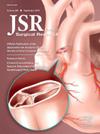小儿抗反流手术减少减酸药物的远期疗效
IF 1.8
3区 医学
Q2 SURGERY
引用次数: 0
摘要
抗反流程序(ARPs)的修订有助于从手术治疗儿科胃食管反流病的转变。然而,长期使用质子泵抑制剂和H2拮抗剂与感染和微量营养素吸收不良有关。本研究探讨ARP对减少减酸药物(ARMs)使用的长期疗效。方法对2000年1月1日至2017年12月31日在单一机构接受ARP的儿科患者进行回顾性队列研究,随访时间至少为6年。资格包括18岁以下接受索引ARP的患者。收集年龄、体重、合并症和ARM使用情况。手术信息包括手术类型和住院疗程。术后信息包括并发症、再手术、术后症状和术后ARMs。t检验比较连续结果,卡方检验比较分类结果的频率。结果共纳入305例患者,平均(标准差)年龄为7.2(6.5)岁,男性占54.7%;70.7%为白人,23%为西班牙裔,5.7%为黑人。腹腔镜下手术占99.3%,开放手术占0.7% (n = 2)。最常见的术前症状是反流(53.4%)和胸骨后疼痛(9.2%)。术后返流发生率最高,为30.8% (n = 94)。最常见的合并症是神经发育迟缓(42%,n = 128)和哮喘(35.7%,n = 109)。11.8% (n = 33)再次手术。随后,2.4% (n = 7)的患者在手术后90 d内,最常见的是膜滑脱(n = 11)或裂孔疝(n = 9)。39.8% (n = 80)的患者在30天内停药,57.4% (n = 156)的患者在最近的随访中停药。它似乎对神经发育迟缓患者最有效。平均随访时间为10年。结论:超过一半的患者在ARP后停用了ARMs,这表明手术仍然有利于减少长期用药。本文章由计算机程序翻译,如有差异,请以英文原文为准。
Long-term Efficacy of Pediatric Anti-reflux Surgery in Reduction of Acid-reducing Medication
Introduction
Revision of anti-reflux procedures (ARPs) has contributed to a shift away from surgical management of pediatric gastroesophageal reflux disease. Long-term proton-pump inhibitor and H2 antagonist use, however, is associated with infection and micronutrient malabsorption. This study investigates long-term ARP efficacy in decreasing acid-reduction medication (ARMs) usage.
Methods
A retrospective cohort study of pediatric patients undergoing ARP at a single institution was conducted from January 1, 2000 to December 31, 2017, allowing for at least a 6-y follow-up. Eligibility included patients less than 18 y undergoing index ARP. Age, weight, comorbidities, and ARM use were collected. Operative information included procedure type and hospital course. Postoperative information included complications, reoperation, postoperative symptoms, and postoperative ARMs. t-Tests compared continuous outcomes, while chi-square test compared frequency of categorical outcomes.
Results
In total, 305 patients were included with a mean (standard deviation) age of 7.2 (6.5) y. In total, 54.7% of patients were male; 70.7% were White, 23% Hispanic, and 5.7% Black. The procedure was laparoscopic for 99.3% and open for 0.7% (n = 2). The most common preoperative symptoms were regurgitation (53.4%) and retrosternal pain (9.2%). Postoperatively, regurgitation remained the most common at 30.8% (n = 94). The most common comorbidities were neurodevelopmental delay (42%, n = 128) and asthma (35.7%, n = 109). 11.8% (n = 33) underwent reoperation. Subsequently, 2.4% (n = 7) of the patients were within 90 d of operation, most commonly for wrap slippage (n = 11) or hiatal hernia (n = 9). AMRs were discontinued in 39.8% (n = 80) of the patients within 30 d and 57.4% (n = 156) at most recent follow-up. It appeared most efficacious for neurodevelopmental delay patients. The mean follow-up was 10 y.
Conclusions
More than half of the patients discontinued ARMs following ARP suggesting that surgery remains beneficial in reducing long-term medication use.
求助全文
通过发布文献求助,成功后即可免费获取论文全文。
去求助
来源期刊
CiteScore
3.90
自引率
4.50%
发文量
627
审稿时长
138 days
期刊介绍:
The Journal of Surgical Research: Clinical and Laboratory Investigation publishes original articles concerned with clinical and laboratory investigations relevant to surgical practice and teaching. The journal emphasizes reports of clinical investigations or fundamental research bearing directly on surgical management that will be of general interest to a broad range of surgeons and surgical researchers. The articles presented need not have been the products of surgeons or of surgical laboratories.
The Journal of Surgical Research also features review articles and special articles relating to educational, research, or social issues of interest to the academic surgical community.

 求助内容:
求助内容: 应助结果提醒方式:
应助结果提醒方式:


